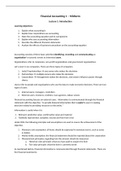Class notes
College aantekeningen Finance 1 for Business (6012B0422Y) Financial Accounting with International Financial Reporting Standards, ISBN:
- Course
- Institution
- Book
College notes Finance 1 for Business (6012B0422Y) Financial Accounting with International Financial Reporting Standards, ISBN: Notes of the first five lectures of the course. These lectures will be part of the mid-term.
[Show more]




